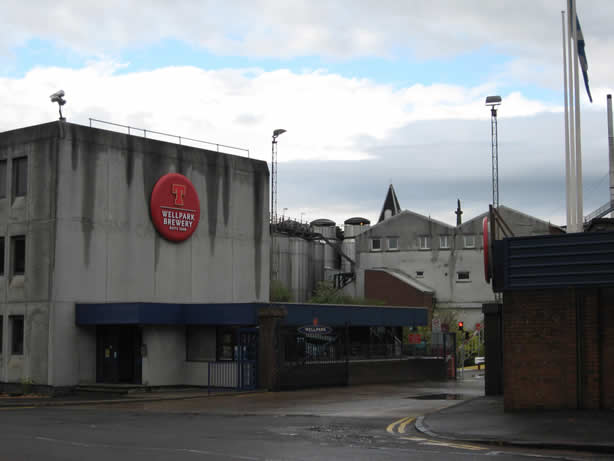
Figure 1: Wellpark Brewery
Initial investigations identified the Wellpark Brewery as the largest individual energy consumer of energy in the area. This makes the brewery a large contributor to the CO2 emissions of the area and it therefore offers the potential for large savings in emissions. The brewing process requires a large amount of energy and the brewery currently consumes 55GWh of natural gas and 22GWh of electricity each year, which equates to 23166 tonnes of CO2 annually. Any attempt to reduce the emissions of this community would have to tackle the industrial emissions to have any real impact so potential options were explored. A combined heat and power system using biomass as a fuel was identified as a possible method to reduce the emissions of the brewery.
A CHP system at the brewery also offers the potential to use some of the heat to install a district heating system in the community. There is an area of 384 council flats owned by Glasgow Housing Association next to the brewery and this was identified as a potential site for district heating. This area is geographically very close to the brewery and the proposed site for the CHP system, which reduces installation costs and heat losses. The fact that the flats are owned in the majority by one housing association would facilitate the installation of the system and reduce the need for agreement between different home owners. It is known that 15% of the households in Dennistoun use electric heating and for this project it has been assumed that these flats use electric heating. The CO2 emissions associated with the electric heating in these 384 flats are 2148 tonnes per year.
Biomass can be an extremely effective method for reducing CO2 emissions however the potential for biomass plants in the UK is limited by the amount of land available to grow energy crops such as wood or Jatropha. This project aims to create a methodology that could be replicated in other communities across the country so any systems proposed must be easily transferable. The mass uptake biomass from energy crops is not realistic so it was decided to investigate the potential for using waste or by-products from the area in the CHP system. A number of potential sources such as waste food or oil from restaurants or households and the use of sewage to produce energy were considered and these have been further investigated in the energy from waste section but spent grain from the brewing process was identified as the most appropriate fuel for this CHP system.
The brewing process produces a large quantity of a by product known as spent grain which can be used as a biomass fuel. Spent grain is often sold on for use as animal fodder and can also be used for growing mushrooms or composting but generally has a relatively low commercial value. Dry spent grain has a calorific value of 21MJ/kg, as this is comparable with some types of coal, spent grain has the potential to be an excellent biomass fuel. As discussed in the design [link] section, the calorific value varies considerably with moisture content and as the spent grain generally leaves the brewing process with around 80% moisture content a large amount of energy would be required to completely dry the grain.
The large amount of spent grain produced at the Wellpark brewery provides the area of Dennistoun with a large biomass fuel source but clearly not every community has a local brewery. Whilst there are a number of other breweries and distilleries in Glasgow that could also implement a similar scheme there are also numerous other industries that produce large amounts of waste that could be used as biomass fuel. Industries as diverse as bakeries and saw-mills produce large amounts of waste that could be harnessed in a CHP system.
Electricity consumption (GWh) |
22 |
Gas consumption (GWh) |
55 |
Beer produced (million hectolitres) |
2.2 |
Spent grain produced at 80% moisture content (thousand tonnes) |
44 |
Table 1: Data on the brewery